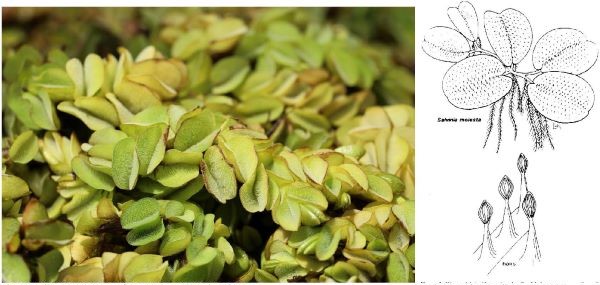Home → Water Quality → Monitoring → Invasives → Giant Salvinia
Giant Salvinia
Salvinia molesta

Photo: USIFAS Center for Aquatic and Invasive Plants. Drawing: Ramey 1990.
Description
Salvinia molesta is a complex of free-floating ferns that does not attach to the soil, but instead remains buoyant on the surface of a body of water. The fronds are 0.5–4 cm long and broad, with a bristly surface caused by the hair-like strands that join at the end providing a waterproof covering for the plant. The fronds are produced in pairs with a third modified root-like frond that hangs in the water.
General Information
S. molesta is often grown as an ornamental plant but has escaped and become a noxious pest in many regions worldwide. There are a few different growth forms for S. molesta. The primary growth form is an invading form with small flat leaves or mat form with large, crowded, folded leaves. Under the best conditions plants can form a two-foot-thick mat. These mats can put a halt to recreational activities on lakes and waterways. S. molesta has been used to extract nutrients and pollutants from the water, and has been accidentally introduced or escaped to countless lakes throughout the United States, including Caddo Lake in Texas, where the invasive species has done extensive damage, killing off other life.